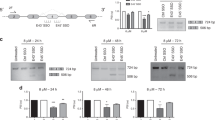Abstract
In previous studies we demonstrated that antisense oligonucleotides (oligos) against transforming growth factor-alpha (TGF-α [MR1]), its binding site the epidermal growth factor receptor (EGFR [MR2]), and the anti-apoptosis protein bcl-2 (MR4) are efficacious against prostate tumors. In recent reports we also describe how two of these mRNA directed binding sites can be synthesized sequentially within a single linear complementary strand and administered either in the presence or absence of additional therapeutic agents.
In these continuing experiments “bispecific” oligo pairs were further evaluated in the presence or absence of Cytoxan, Taxol, or DES. One oligo pair recognized the binding sites for TGF-α and EGFR mRNA (TGF-α/EGFR [MR12] and EGFR/TGF-α [MR21]); another pair recognized binding sites for EGFR and bcl-2 (EGFR/bcl-2 [MR24] and bcl-2/EGFR [MR42]). Oligo pairs differ in their linear 5′ to 3′ binding site orientations, and were tested in vitro against PC-3 and LNCaP prostate tumor cell lines. Following cell attachment, incubations were for 2 days with the agents followed by 2 days in their absence.
When tested against PC-3 cells and combined with LD50 Cytoxan, MR2, MR4, MR24, MR42 significantly inhibited 47.3, 45.7, 68.3, and 64.9%; with LD50 Taxol MR2, MR4, MR24, MR42 significantly inhibited 49.8, 45.8, 64.1, and 59.2%; and with LD50 DES MR2, MR4, MR24, MR42 significantly inhibited 66.6, 67.6, 64.3, and 67.2% respectively. Each agent significantly increased the inhibition produced by either oligo alone.
LNCaP cells were also incubated with mono- and bispecific oligos in either the presence or absence of chemotherapeutics. MR2, MR4, MR24, MR42 produced significant inhibitions of 57.4, 58.4, 69.4, and 68.6% with LD50 Cytoxan; 70.4, 70.1, 73.6, and 74.0% with LD50 Taxol; and 49.8, 50.1, 59.6, and 53.9%, respectively with LD50 DES.
A complete PC-3 experiment compared MR1, MR2, MR4, MR12, MR21, MR24 and MR42, in the presence of LD50 Cytoxan. Each oligo combined with Cytoxan significantly inhibited: MR1 by 51.0, MR2 by 55.0, MR4 by 58.0; MR12 by 56.0; MR21 by 61.1, MR24 by 65.5 and MR42 by 66.0%. Bispecifics directed against two different pathways, MR24, and MR42 were the most effective.
A complete LNCaP experiment compared the same series of oligos also in the presence of LD50 Cytoxan. Each oligo combined with Cytoxan significantly inhibited: MR1 by 49.0, MR2 by 50.0, MR4 by 53.0; MR12 by 52.0; MR21 by 58.6, MR24 by 53.9 and MR42 by 58.0%.






Similar content being viewed by others
References
Rubenstein M, Tsui P, Guinan P. Construction of a bispecific antisense oligonucleotide containing multiple binding sites for the treatment of hormone insensitive prostate tumors. Med Hypotheses 2005;65:905–7.
Rubenstein M, Tsui P, Guinan P. Bispecific antisense oligonucleotides with multiple binding sites for the treatment of prostate tumors and their applicability to combination therapy. Methods Find Exp Clin Pharmacol 2006;28:1–4.
Rubenstein M, Tsui P, Guinan P. Bispecific antisense oligonucleotides having binding sites directed against an autocrine regulated growth pathway and bcl-2 for the treatment of prostate tumors. (In Press Med Oncol 2007:24).
Rubenstein M, Anderson KM, Tsui P, Guinan P. Synthesis of branched antisense oligonucleotides having multiple specificities: treatment of hormone insensitive prostate cancer. Med Hypotheses 2006;67:1374–79.
Rubenstein M, Mirochnik Y, Chou P, Guinan P. Antisense oligonucleotide intralesional therapy for human PC-3 prostate tumors carried in athymic nude mice. J Surg Oncol 1996;62:194–200.
Yamanaka K, Miyake H, Zangemeister-wittke U, Jansen B, Gleave M. Novel bispecific antisense oligonucleotides inhibiting both Bcl-2 and Bcl-xL expression induce apoptosis and enhance chemosensitivity in human androgen-independent prostate cancer cells. Proc Am Assoc Cancer Res 2004;45:Abstract #2930.
Lee BS, Fujita M, Khazenzon NM, Wachsmann-Hogiu S, Farkas DL, Black KL, Ljubimova JY, Holler E. Synthesis of polymeric prodrug Polycefin based on biodegradable poly (malic acid) for drug delivery. Proc Am Assoc Cancer Res 2006;97:258a.
Rubenstein M, Tsui P, Guinan P. A review of antisense oligonucleotides in the treatment of human disease. Drugs of the Future 2004;29:893–909.
Gleave M, Tolcher A, Miyake H, Nelson C, Brown B, Beraldi E, Goldie J. Progression to androgen independence is delayed by adjuvant treatment with antisense bcl-2 oligodeoxynucleotides after castration in the LNCaP prostate tumor model. Clin Cancer Res 1999;5:2891–98.
Rubenstein M, Slobodskoy L, Mirochnik Y, Guinan P. Inhibition of PC-3 prostate cancer cell growth in vitro using both antisense oligonucleotides and Taxol. Med Oncol 2003;20:29–35.
Tsui P, Rubenstein M, Guinan P. Synergistic effects of combination therapy employing antisense oligonucleotides with traditional chemotherapeutics in the PC-3 prostate cancer model. Med Oncol 2004;21:339–48.
Zamecnik PC, Stephenson ML. Inhibition of Rous sarcoma virus replication and transformation by a specific deoxynucleotide. Proc Natl Acad Sci USA 1979;75:280–4.
Mirochnik Y, Rubenstein M, Guinan P. Two constructed antibody derived delivery vehicles for targeting oligodeoxynucleotides to prostate tumors expressing prostate specific antigen. Drug Del 2004;11:161–7.
Castelli J, Wood KA, Youle RJ. The 2-5A system in viral infection and apoptosis. Biomed Pharmacother 1998;52:386–90.
Kondo S, Kondo Y, Li G, Silverman RH, Cowell JK. Targeted therapy of human malignant glioma in a mouse model by 2-5A antisense directed against telomerase RNA. Oncogene 1998;16:3323–30.
Ying SY, Lin S. High-performance subtractive hybridization of cDNSs by covalent bonding between complementary nucleotides. Biotechniques 1999;26:966–79.
Ying SY, Chuong CM, Lin S. Suppression of activin-induced apoptosis by novel antisense strategy in human prostate cancer cells. Biochem Biophys Res Commun 1999;265:669–73.
Acknowledgments
The Cellular Biology laboratory at the Hektoen Institute is supported, in part, by the Blum Kovler Foundation, the Cancer Federation, Safeway/Dominicks Foundation, Lawn Manor Beth Jacob Hebrew Congregation, the Sternfeld Family Foundation, and the Herbert C. Wenske Foundation.
Author information
Authors and Affiliations
Corresponding author
Rights and permissions
About this article
Cite this article
Rubenstein, M., Tsui, P. & Guinan, P. Combination chemotherapy employing bispecific antisense oligonucleotides having binding sites directed against an autocrine regulated growth pathway and bcl-2 for the treatment of prostate tumors. Med Oncol 24, 372–378 (2007). https://doi.org/10.1007/s12032-007-0023-y
Received:
Accepted:
Published:
Issue Date:
DOI: https://doi.org/10.1007/s12032-007-0023-y




